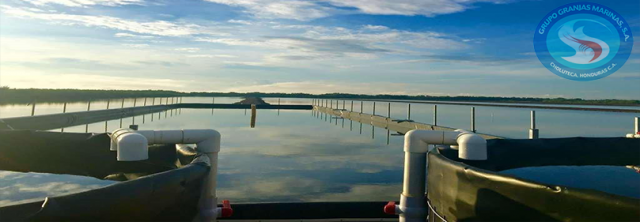
GRANJAS MARINAS READY TO EXPAND “SOLAR SHRIMP” MODEL IN HONDURAS
Matt Craze / Undercurrent News
SAN LORENZO, Honduras — Grupo Granjas Marinas (GGM) has enjoyed continued success to rethinking shrimp farm methods in the face of significant industry challenges and plans to expand the model.
Brian Boudreau, GGM’s head of aquaculture, inspects an raceway that sits in the middle of a large shrimp pond in the searing heat of southwest Honduras. The installation is part of a system that he and his team helped build. It could turn the concept of shrimp farming on its head.
The raceways are a growing feature at Honduras’s larger shrimp farms as companies combat the spread of vibriosis that reportedly originated from Mexico. The raceways with their flow-through system of water have improved survival rates in larvae, compared with traditional nurseries.
What makes GGM’s system different is that the raceways are open and the post-larvae are fed exclusively with marine diatoms. Survival rates have improved and GGM is on course to produce 30.5 million pounds of shrimp this year, a 7% increase on last year.
Boudreau said another innovation was to carve semi-extensive 25 plus-hectare shrimp ponds into three portions. The larger shrimp that are closest to harvest time occupy the outer third portion. The system better matches the amount of biomass and water with conflicting requirements to improve control.
“It is better business to have your shrimp growing at this rate,” he says. “We want to harness the sun’s energy through diatoms,” he said.
Victor Wilson, the company’s CEO, jokingly calls the animals “solar shrimp”.
The company is so confident in its techniques that Nancy Murillo, a key member of Boudreau’s team, gave an presentation about the company’s techniques at the recent Central American Aquaculture Symposium (SIMCAA) in Honduras, the only local company to present findings.
Murillo was part of a team that helped discover the diatoms. The method also works because the company keeps low densities of shrimp in its ponds, a key element of its defense strategy in the fight against vibriosis and other illnesses.
Honduras lends itself to the use of open raceways, defying conventional shrimp farming wisdom, because of its extremely hot temperatures, which only require the occasional use of aeration to ensure the post larvae’s high survival rates, Boudreau said.
The ratio of open raceways to closed raceways is currently 22 to 48 and the company plans to further expand Boudreau’s model, coined as multi-phase inventory management system (MIMS).
By the time GGM, the world’s 31st largest shrimp farmer and a supplier to UK supermarket Marks & Spencer, has finished its current plan, San Bernardo, the world’s largest shrimp farm by acreage, will have over 500 ponds. It has 245 now.
Google Earth holds testimony to Boudreau’s work. Instead of the rectangular ponds that can be observed in major shrimp-growing areas such as the delta near Guayaquil in Ecuador, some of GGM productive areas show thin matchstick-like ponds that are the result of MIMS.
Boudreau, a biology graduate from the University of Guelph in Ontario, started his career in the late 1980s at a small shrimp farm in Ecuador, before moving to Honduras in the 1980s. Working at GGM throughout the 1980s and 1990s, he returned to North America in the previous decade and worked in intensive shrimp farming, returning to Honduras in 2010.
There he was recruited by Wilson, the company’s CEO and a former Cargill executive who stayed on as CEO even as GGM underwent a change of ownership. The company’s processing plant at the port of San Lorenzo has the capacity to handle up to 200,000 pounds of shrimp daily.
The diatoms used to feed the post larvae are nutritionally rich and contain abundant Omega-3 fatty acids, Boudreau says. The diatoms produce food from sunlight and the open raceways at a cost of $60,000 each are far cheaper than closed models, he said. The company has achieved biomass growth of over 1,000 pounds in one week, he added.
Companies that have managed to buck the trend of wide-scale losses caused by early mortality syndrome (EMS), a consequence of vibrio, have enjoyed a prolonged spell of higher prices. Farmers in Ecuador, who are also well known for farming in low densities, have also emerged as winners in an industry beset with biological challenges.
“High density is not a path to follow,” says Boudreau. “Our MIMS model is the way towards a more sustainable future.”
Comentarios
No se han publicado comentarios
Deja tu comentario